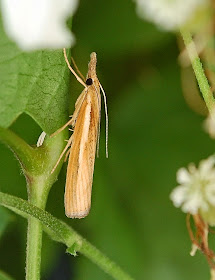I potted a few micros for id and returned at 12.45 for a last check. The black and white moth had now taken to roosting upside down on the perspex of the Skinner trap and it was immediately obvious it was a new moth for me. Carefully, it was potted and then it could be seen it was not only a new moth for me, it was one I had never seen before in any moth field guide that I had.
Got a poor photo and sent to mothing mate in Stortford, words "What the f is this?" Graeme texted back with a suggestion but didn't quite grasp the size, some 4cm wingspan. Once he was aware of this, (the word feek was common,) he and I started searching for possibilities. Don't know why but I had a feeling it was a micro rather than macro, regardless of size. Graeme then texted "phone me!" I did and he said put 1409a into UK moths and there it was, Diaphania perspectalis, probably a 1st for Hertfordshire.
 |
| Diaphania perspectalis |
A serious pest species of box: see short video of larvae here.
It originates from Japan and has spread all over Asia, arriving in Germany 2007, The Netherlands and UK 2008. It seems as if the 1st UK record was Sept 2008. I am still trying to find out how many British records there are.
A stunning looking moth that, unfortunately, will have to be killed as they are seriously invasive and, probably, already populous enough in Britain that they cannot be eradicated.
Now need to find who in our village has put in some box hedging over the last year and keep an eye open for larvae. Need to do more research to find when these emerge so can find if it has become an unwelcome resident within the village. I have reported this to agencies concerned with non native species and pest species. I await their response. Have now received info and nonnative secretariat have forwarded to RHS. They sent me this link. Note change of name.
rhs link
Fact sheet, click here
Apart from all that excitement, a Stenoptilia pterodactyla was new for the year in a low haul of 46 moths of 12 macro species and 10 micro.
 |
| carcina quercana |
 |
| Agriphila straminella, I think! |
No comments:
Post a Comment